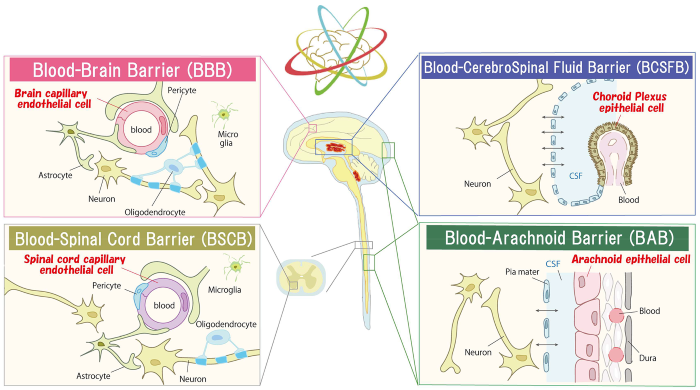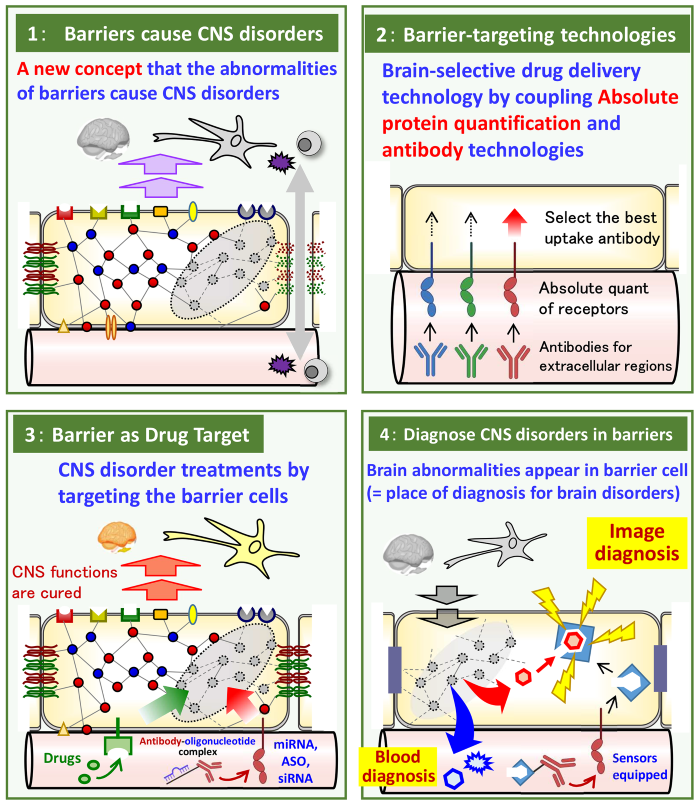Prof. UCHIDA Yasuo

【Research Keywords】
Drug discovery and treatment of various central nervous system disorders, Systems biology, Quantitative proteomics, Pharmacokinetics, Pharmaceutics, Blood-brain barrier, Blood-arachnoid barrier, Blood cerebrospinal fluid barrier, Blood-spinal cord barrier, Human pathological brain tissues, Transporters, Receptors, Mass spectrometry, Drug delivery
【Recent highlights】
We are developing cutting-edge research together with many students who are highly motivated in their research. We possess the technology to simultaneously quantify the abundance of thousands of proteins with high accuracy and sensitivity for membrane proteins by quantitative proteomics, which can be applied to a wide variety of samples including frozen and FFPE human tissues, animals, cells, plants, insects, and microorganisms (The Young Scientists' Award, The Commendation for Science and Technology by the Minister of Education, Culture, Sports, Science and Technology). We aim to open up the next generation of pharmaceutics called 'Molecular Systems Pharmaceutics', and to elucidate the mysteries of the brain, brain activity and the molecular mechanisms of human central nervous system disorders, as well as drug discovery for those disorders.
【Recent News】
1. Dr Hashimoto will organize the international symposium of brain barrier research in Oct 2025.
2. The original homepage of our laboratory has been updated.
3. March 2025: Our laboratory students made presentations in the 145th Annual Meeting of the Pharmaceutical Society of Japan.
4. A 2nd-year pharmacy student will make a presentation in scientific conference this year.
Feel free to contact us if any other students are also seriously considering a future career in research (in industry or academia).
5. October 2024: 5 third-year students and 1 international student from China were assigned to our lab.
Our lab financially supports students' conference presentations and international exchanges by JSPS bilateral project.
【Student Employment】
The most common employment opportunities for laboratory students are researchers in pharmaceutical companies after getting a Ph.D. degree.
Profiles of Faculty and Research Scholars
【Major Papers of the Laboratory】
・Uchida Y, Sasaki H, Terasaki T. Establishment and validation of highly accurate formalin-fixed paraffin-embedded quantitative proteomics by heat-compatible pressure cycling technology using phase-transfer surfactant and SWATH-MS, Sci Rep, 2020;10:11271.
・Handa T, Sasaki H, Takao M, Tano M, Uchida Y. Proteomics-based investigation of cerebrovascular molecular mechanisms in cerebral amyloid angiopathy by the FFPE-LMD-PCT-SWATH method. Fluids Barriers CNS. 2022;19(1):56.
・Uchida Y, Goto R, Usui T, Tachikawa M, Terasaki T. Blood-arachnoid barrier as a dynamic physiological and pharmacological interface between cerebrospinal fluid and blood.“Drug Delivery to the Brain - Physiological Concepts, Methodologies and Approaches”, ed., by R. Thorne, L. de Lange, M. Hammarlund-Udenaes, Springer, pp 93-121, 2022.
・Hashimoto Y, Zhou W, Hamauchi K, Shirakura K, Doi T, Yagi K, Sawasaki T, Okada Y, Kondoh M, Takeda H. Engineered membrane protein antigens successfully induce antibodies against extracellular regions of claudin-5. Sci Rep. 2018;8(1):8383.
・Akai M, Maeda Y, Kawami M, Yumoto R, Takano M, Uchida Y. miR-PAIR: microRNAs-Proteins Analysis of Integrative Relationship for the identification of significant miRNAs. Biochim Biophys Acta Gen Subj, 2025;1869(2):130746.
【Education】
Lectures and practical training provide general education in the fundamentals of pharmacokinetics and pharmaceutics. Once assigned to a laboratory, students are educated to acquire a broad cross-disciplinary perspective based on these disciplines, incorporating a variety of disciplines and techniques such as biochemistry, molecular biology, pharmacology, analytical chemistry, bioinformatics and proteomics.
Research is an activity in which everyone has the potential to succeed and excel, regardless of their lecture grades during their undergraduate years. The key to this is whether you enjoy it. It takes a certain amount of effort and time to be able to enjoy any art or sport as an athlete. In research, there is the pleasure of being the first person in the world to discover something that no one else in the world has seen, and the pleasure of being able to experimentally prove your ideas. We will do our best to support you so that you can enjoy this pleasure.
We also encourage you to take up the challenge of a Ph.D. Your twenties are the time in your life when you can test and develop yourself the most. It is said that the talks of people who have been immersed in one thing for five years or more is interesting. A Ph.D. is an invaluable life confidence, as the problem-solving skills developed through a variety of experiences and trial-and-error during Ph.D. course can be applied to any field and in a wide variety of occupations.


【Research】
In addition to the blood-brain barrier (BBB), three types of barrier tissue exist in the central nervous system (CNS): the blood-cerebrospinal fluid barrier (BCSFB), the blood-arachnoid barrier (BAB) and the blood-spinal cord barrier (BSCB), which separate the peripheral (blood) and CNS tissues. Collectively, these are called the “CNS barriers”.

Challenges in the development of new drugs for the treatment of CNS diseases
(1) As the general concept is that the target molecules of drugs exist in the CNS beyond the CNS barrier, (2) drugs need to pass through the CNS barrier to reach the CNS, but more than 99% of drugs are prevented from entering the CNS by efflux pumps such as P-glycoprotein (P-gp). (3) Proteins, genes, nanoparticles and other macromolecules cannot pass through the CNS barrier at all. Thus, we cannot expect a future in which we can efficiently develop drugs for the treatment of CNS diseases if we continue with existing technologies and ideas in the future.
In contrast, we focus on the cells of the CNS barrier itself as a target for therapeutic and diagnostic drugs to solve the problem of brain drug distribution (drug discovery that does not require the drug penetration across CNS barriers) and then open up a new drug discovery field for CNS diseases. Since the CNS barrier affects the brain environment, one of the important causes of diseases in the CNS is the abnormality of the barrier (the barrier also gets abnormal as a result of pathologies in the CNS tissues). Our goal is to establish a new and unprecedented drug discovery strategy to treat and diagnose CNS diseases by treating and diagnosing the abnormalities of the barrier. We are working daily to realize the following four concepts, with the goal of creating a new academic discipline “CNS barrier-based Drug Discovery Science”.

Concept 1.
Elucidate the pathomechanisms of the CNS barrier in CNS diseases and prove its contribution to the onset and progression of CNS diseases. Our strength is that we possess the technology to elucidate the pathological molecular mechanisms of the CNS not only in mice but also in humans by quantitative proteomics. In particular, it has been difficult to quantitatively analyze comprehensive molecular mechanisms in human tissue samples because they are fixed in formalin. We have developed our own highly accurate quantitative proteomics technology for formalin-fixed paraffin-embedded sections (FFPE), and are performing quantitative proteomics analysis for the human diseased CNS barriers by collecting their barrier tissues using laser microdissection. By selectively regulating the expression of the responsible molecules or molecular mechanisms identified in quantitative proteomics analysis using adeno-associated virus (AAV) in vivo gene engineering technology, we will prove their contribution to the onset and progression of CNS disease pathologies.
Concept 2.
We will establish a technology to efficiently deliver antibodies into the each CNS barrier cell by identifying membrane proteins that are more highly expressed in the CNS barriers than in other organs, producing antibodies, and evaluating the uptake rate. Our strength is that we have developed a technology to comprehensively and precisely quantify the absolute expression levels (mole) of membrane proteins (quantitative Global Absolute Proteomics (qGAP) method). Using this technology, we comprehensively elucidate the absolute expression levels of membrane proteins localized on the blood-side plasma membrane of CNS barrier cells, and select membrane proteins that are selectively highly expressed in each CNS barrier compared to other organs. Antibodies against the extracellular regions of the candidate membrane proteins are produced, and the antibodies that are most rapidly taken up into the CNS barrier cells are identified from among multiple antibody candidates.
Concept 3.
We demonstrate the efficacy of CNS disease therapies that target the CNS barrier. Our strength is that we have developed own algorithms that can predict small molecule drugs and nucleic acid sequences (miRNA, ASO, siRNA) that can normalize pathological molecular mechanisms (changes in various protein expression levels in pathological conditions). For example, conventional methods for predicting therapeutic miRNA sequences select miRNA sequences that are expected to normalize the pathology based on transcriptome data during the pathological state, but they are unable to sufficiently normalize the pathological molecular mechanism at the protein expression level. In contrast, the “miR-PAIR method”, an algorithm we developed, can predict miRNA sequences that can normalize the molecular mechanisms of a group of proteins directly related to pathological conditions. Using these techniques, we will select small molecule drugs, miRNAs, and ASO/siRNAs that can normalize the pathological molecular mechanisms of the CNS barriers to be elucidated in Concept 1 (nucleic acids will be complexed with antibodies in Concept 2), and demonstrate that they can treat CNS disease pathologies using diseased animal models.
Concept 4.
We will establish the diagnostic method to diagnose the environment in the brain parenchyma (CNS disorders) by measuring the state of the CNS barrier. By modifying an imaging probe to the antibody to be developed in Concept 2 and administering it, a diagnostic probe can be introduced into the CNS barrier cells and the environment of the CNS barriers can be measured. Since the brain parenchyma and the CNS barriers interact with each other, abnormalities in the brain parenchyma will appear in the CNS barriers. In addition to imaging diagnosis using the diagnostic probe, we also develop the blood diagnosis for disease biomarkers that leak from the CNS barrier cells into the bloodstream, in order to establish a new diagnostic foundation “CNS barrier diagnosis” for CNS diseases.

 Home
Home





